

Pages in this Folder:

Related Folders:
See also Department Site Map
Support Provided by

Toronto Parks and Trees Foundation

This website has received support from celos.ca through the Trillium foundation.
Publications
Comments?
For the basics, see
- Website & Privacy Policies
- How To Get Involved
- The Role of the Park
Search options:
Department Site Map
Custodians:
 Twelfth Night
Twelfth Night
Twelfth Night: January 5 2010
Photos were taken by Teresa Vanneste
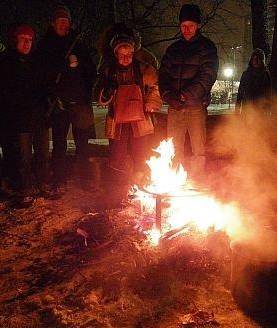
The thirteenth fire, snow all around
Working notes, from Jane Wells: Last week, on January 5th, a small group gathered at Dufferin Grove Park to observe old Twelfth Night, the evening before Epiphany, or Twelfth Day, or Old Christmas Day. Called many things, it is the finale of the Christmas celebration, almost certainly drawing on pre-Christian ritual to recognize the dark cold of winter, remind us of the distant spring, and make some charm for a good harvest to ease the winter next. In putting together this workshop of Twelfth Night, I drew on accounts from various regional British traditions, many apparently medieval, but not exclusively.
- We gathered behind the big oven, where noise-makers were handed out and a few jobs assigned.
- We were then greeted by Old Meg, a crone with a lantern. Played by Bruce Beaton (cross-dressing and disguise were a big part of medieval Twelfth Night parties), Old Meg was the name for the 13th and largest fire of the evening, which also sometimes had a straw figure, the old meg, in the centre of it. Creepy, but interesting!
- She led us to the two cherry trees, where declamations were made, caraway toast was hung from the branches, and cider poured down each trunk. This ‘wassailing of the fruit tree’ was traditionally done to apple trees, and in rural areas of the southern UK was the main event of a Twelfth Night.
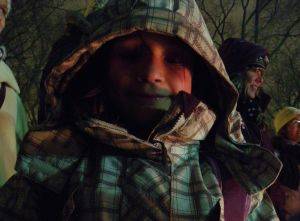
- Old Meg then led us into the dark, towards Dufferin and the path through the gully.
- Before we reached the path we were halted by Mr. Bump, a local character created by Sean Dixon originally to slow traffic on his street on Hallowe’en.
- Here he was a stand in for Herod: apparently medieval feasts on this night culminated in a dramatic encounter between the Magi and Herod, who is trying to find the Christ child. The Three Kings outwit him and make their way to the stable to present their three gifts. Mr. Bump, a plump officious fellow with a bird mask stopped us;
- Old Meg tried to find the problem –were we too loud? Was it that we had no permit? They had a brief duel with their walking sticks, and then Mr. Bump sniffed out the gifts our crowd was carrying; three bundles of herbs given out at the beginning of the walk.
- Sure enough this earned our passage, and Mr. Bump then accompanied us through the gully.
- Along the path were candles, six on each bank, spaced apart to reach the steps that rise to the fire pit. As we sang the words to Oranges and Lemons (traditionally used on Twelfth Night during a Tug of War), Mr. Bump rang a school bell following each line, and a candle was lit. That was the plan! Candles outside in winter, always a challenge, and our two tenacious lamplighters tried manfully to light each one. It didn’t quite work, but those that lit looked beautiful, nestled in their brown bags (thanks to David Anderson for that!).
- When we arrived at the steps, theoretically having passed the twelve ‘fires’ of Twelfth Night, Old Meg and Mr. Bump formed an arch with their canes and we passed through, coming to the last and largest 13th fire at the fire pit. There was a final song and a few words spoken, followed by cider and caraway seed cookies.
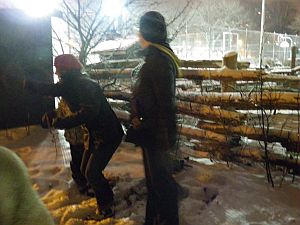
Next Year:
- Next year, if we wassail forth again, I would keep the general shape of the evening, and especially the characters, who seemed timeless. I could see them as figures that step out each year (with perhaps one more) in the spirit of the Mummer’s plays, but with our own archetypes.
- I would like to have more music! A friend who knows wassailing songs was going to join us and sing as we walked, but had to bow out at the last minute. I had forgotten that David Anderson knew these songs as well, or would have called him into service. We needed more clamour, and clatter, it felt necessary as we walked through the dark. So, more bells and noisemakers. But I also want to find songs that people are likely to know, so there is clear space for participation along the way.
- The failure of the candles to light calls for an alternative. As they were stand-ins for the twelve fires, I would love to actually have twelve small fires along our route, which would provide a more significant contrast to the impressive light throw from the rink.
- Our final gathering at Old Meg’s fire could have more distinction to it, so it is clearly a destination, not just a private fire, but one patently welcoming to passersby, so they can join even if they don’t know why.
- Jutta proposed this Night as a workshop, to see if it was something we might do another, or every year. While this account is primarily a summary of what we would keep, change, try again next year, the whole experience raised for me the question of not just how to do it, but why.
- Do we need more events? No. More activities? Nope. We might not have the medieval stamina for twelve days of celebration. Our arc lasts just over a week from Christmas Eve to New Year’s Day. Of course there’s many a party in the weeks leading up to our winter holiday, so maybe that’s why we are all so pooped by Boxing Day. Plus shopping! Those lucky pagans and medievalists didn’t have to shop.
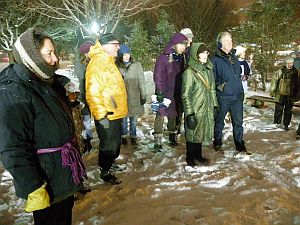
For me, the celebrations around Christmas feel less like ritual, and more like habit. The challenge of re-creating old ceremonies is to give everyone a dip, however brief, into the taproot of an ancient tradition. Like many people, I have a longing for ritual and for the moment of transformation where something magic and impossible happens. In that moment, somehow you know what will happen next, it makes sense as it unfolds, and you feel that this has all happened before.
The needs that drove such a celebration five hundred or a thousand years ago, light in the darkness, the guarantee of a good harvest, are no longer ours. But need is the essence of finding an event’s heart, and I think there is a potential for transformation and unity in Twelfth Night that deserve the right celebration.
Dufferin Grove does not need more light, no city space does.The need is not for light, but it might be for fire. For the way it simultaneously claims space and welcomes people – it is naturally democratic. An act of protest and an invitation. Fire also promotes gathering in defiance of cold – and bureaucracy!
And although the park is like plasticine in its many uses and services, its empty wintry landscape is an irresistible canvas. When public space is transformed, we are all electrified by seeing something familiar in a new and changed way. This is particularly effective in the dark, when shapes take on new form, and particularly welcome in January, when the world starts to feel unbearably prosaic.
Jane wells


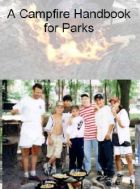
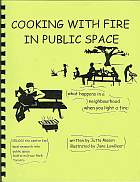


 Printer friendly version
Printer friendly version